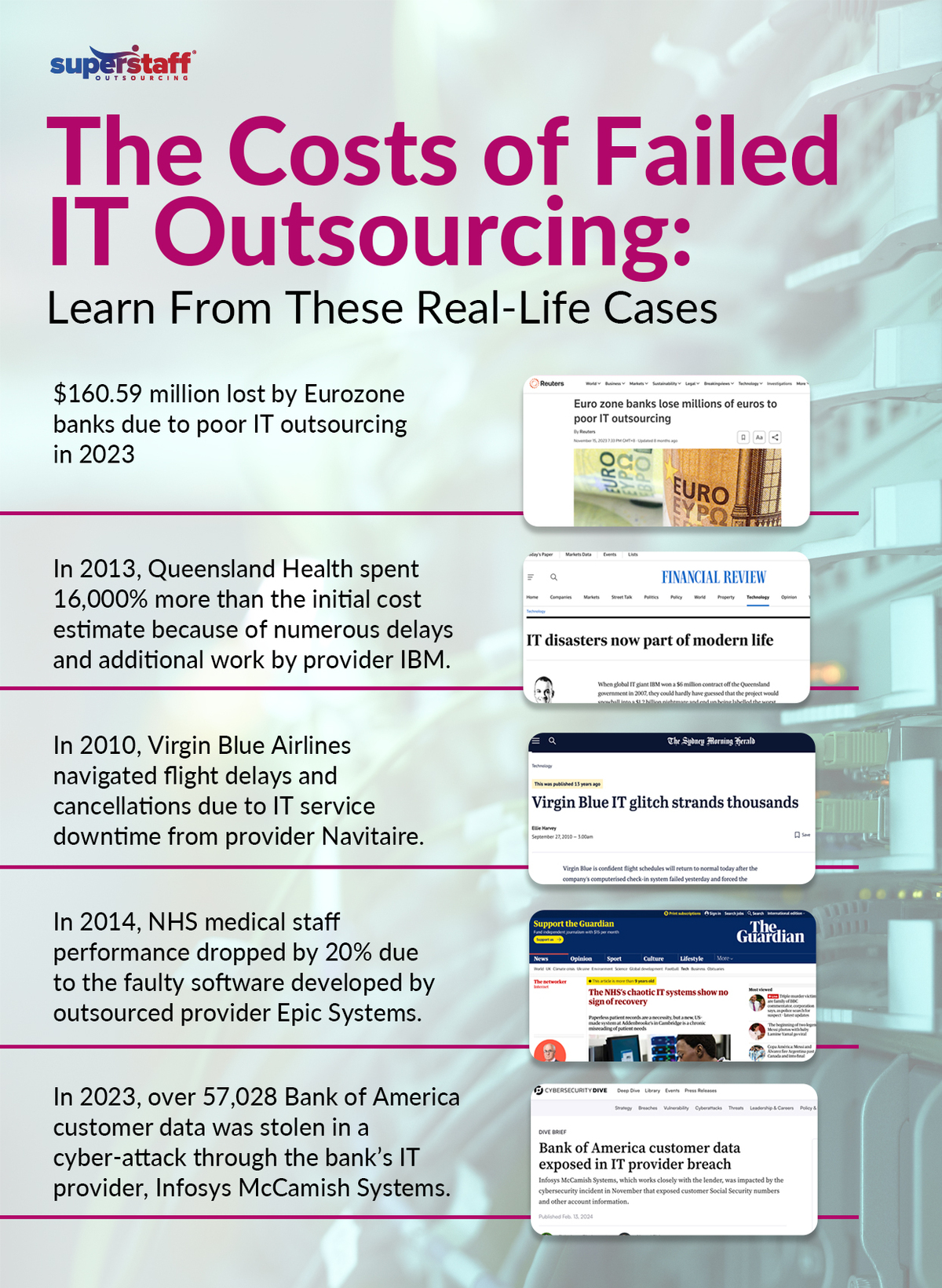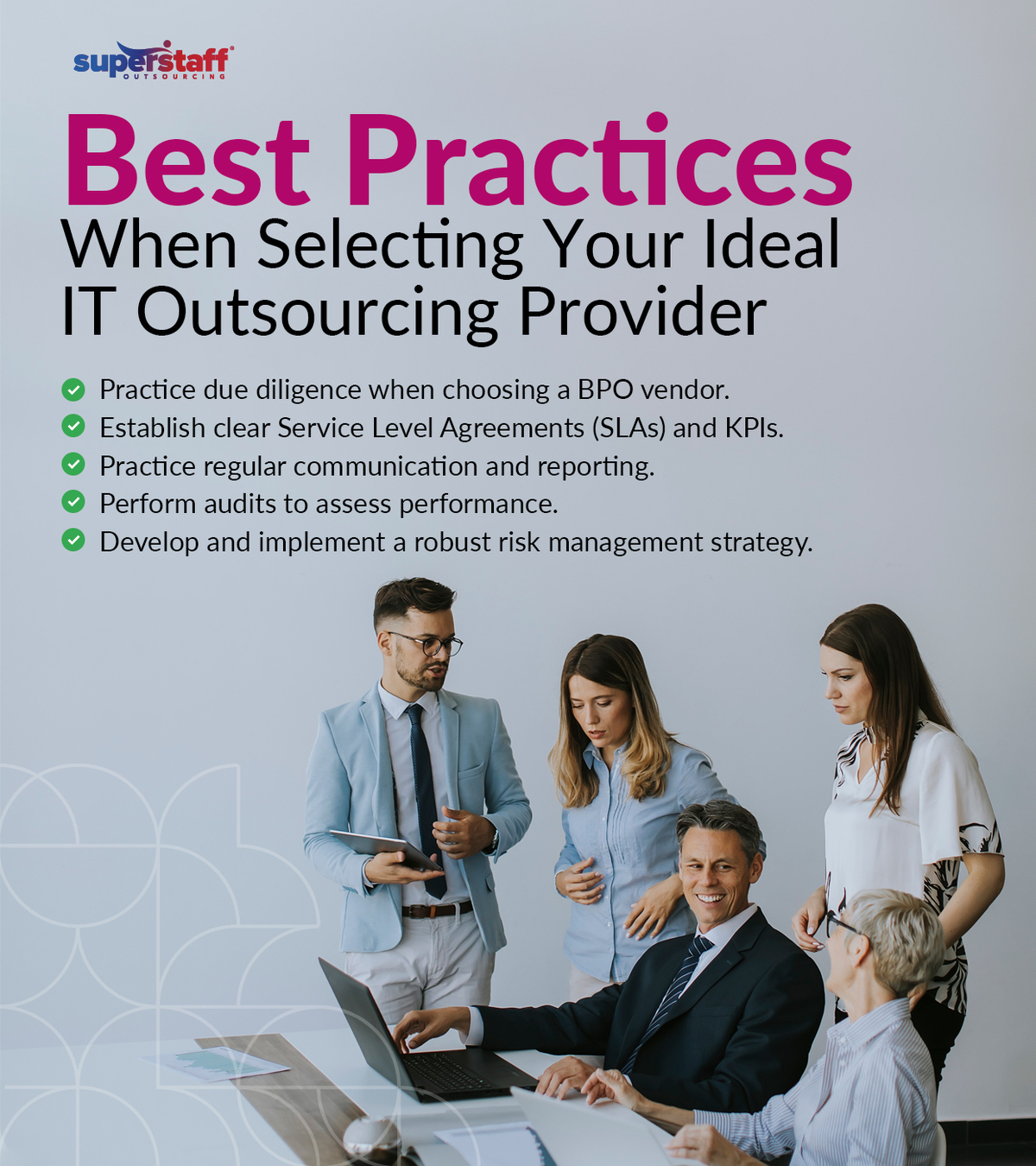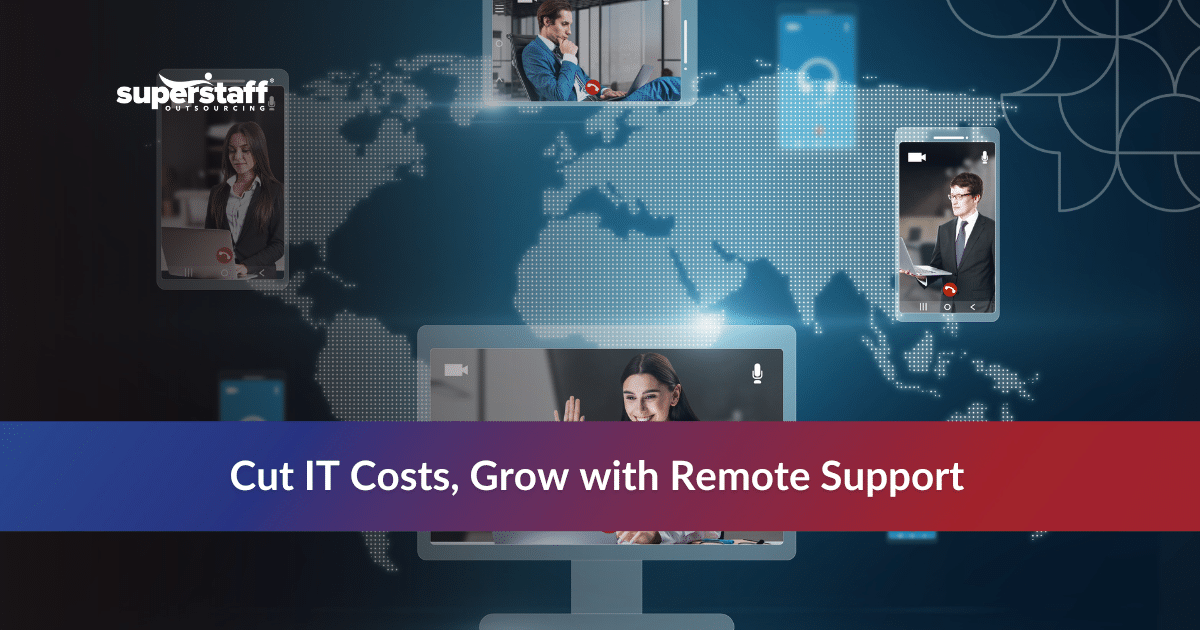
As a business leader, you may know the advantages of having a robust tech infrastructure and a solid information technology system. However, have you ever wondered about the consequences of poor IT management? What happens when you partner with an IT provider that can’t meet your needs?
Before you make a commitment to an IT business process outsourcing provider, it’s crucial that you take the time to thoroughly vet all candidates. Failing to select the right vendor can lead to significant and far-reaching costs for your organization.
Case in point: In 2023, Eurozone banks lost millions of euros to poor IT outsourcing. The subpar quality of outsourced services created a 360% increase in expenses while simultaneously creating cybersecurity and performance issues.
And sadly, Eurozone banks are not alone in falling prey to abysmal outsourced IT services. To help you avoid this situation, we’ll break down the hidden costs of poor IT outsourcing by studying different real-life sample cases. Then, we’ll guide you through how to mitigate the risks and find your ideal provider.
Breaking Down the True Costs of Poor IT Outsourcing

Choosing the right IT services outsourcing provider is crucial to your organization’s success and financial health. Making the wrong choice can create quality and performance issues, disrupt your operations, affect customer relationships, and negatively impact your bottom line. Here are some of the critical areas where the costs of poor IT outsourcing manifest:
#1: Financial Costs
Poorly managed IT outsourcing services can create significant and unexpected financial consequences for your business. Delays and extra work often result in budget overruns, which can add up until you’ve realized that you’ve sunk more into your project than you can hope to gain back in profit.
To illustrate, let’s study the case of the Queensland Health Department. In 2013, Queensland Health hired IBM to help them develop a new payroll administration app to modernize their legacy systems and ultimately provide a better experience for employees and patients.
Initially, IBM estimated Queensland’s project cost at about $6 million. Throughout development, they realized the job would take longer and cost more than expected. By the end of the year, IBM adjusted the estimate to $27 million.
However, the project continued for years, adding more and more extra costs. By the time the payroll application was completed, the final price was $1.2 billion—about 16,000% more than the initial estimate!
This sample case illustrates the importance of due diligence when selecting an outsourced IT partner. The right provider will be transparent about costs and provide a realistic estimate and timeline for project completion.
Hidden Costs
Let’s break this down even further. What specific financial costs can occur when an outsourced IT project is poorly managed? First, your company may face a multitude of hidden expenses. Unanticipated costs such as transition, travel, and fees for managing the relationship can add up.
In the case of Queensland Health and IBM, one factor that led to the failure of their partnership was the inadequate documentation of business requirements at the beginning. Because of the lack of a defined scope for the project, unexpected delays and disruptions continued, extra work needed to be accomplished, and expenses piled on and on.
Penalties and Fines
Beyond hidden expenses, penalties and fines are another financial consequence of poor IT outsource services. If your IT partner’s quality of outsourced work fails to meet regulatory requirements nationally or internationally, your organization may face hefty legal penalties and fines.
Because of issues with their IBM-developed payroll system, Queensland Health overpaid staff by $112.3 million. Although $16.5 million has been repaid and $3.3 million has been waived, the organization had an obligation under the Financial Accountability Act 2009 to recover the $9 million outstanding balance. They were also required to fund fringe benefit tax (FBT) liabilities associated with the overpayments, creating an additional cost burden of $1.7 million.
Vendor Lock-In
Finally, another financial cost of poor IT outsourcing is vendor lock-in. There will always be financial penalties for breaking the terms of a contract. So, even if a company may realize, mid-project, that a provider’s quality of work isn’t meeting its expectations, it cannot simply break off the partnership if it had agreed to a specific timeline. Organizations might find it difficult and costly to switch vendors, leading to a lack of flexibility.
#2: Quality and Performance Issues
Financial consequences are not the only costs of doing business with subpar outsourced IT support. Delegating critical technology functions to the wrong vendor can lead to losing control over strategic decisions and innovations, resulting in substandard deliverables and a lower overall quality of IT services.
Here’s a real-life sample case that illustrates how an IT provider’s quality and performance issues can be costly for businesses: In 2009, the state of Indiana hired IBM to reinvent its welfare processing system, hoping to introduce a new service delivery model that allows citizens to make Medicaid, food stamp, and other benefit claims online or over the phone.
The project, which cost roughly $1.6 billion, resulted in a final product riddled with technical glitches, bugs, and errors. Applicants complained about significantly long service wait times, slow processing of eligibility requests, incorrect claim denials, and other problems that affected their ability to claim much-needed benefits.
Indiana and IBM sued each other for breach of contract. Still, the Court of Appeals eventually ruled that the outsourcing provider owed the state $78 million in damages for failing to properly automate their online welfare processing system.
Downtime
Selecting the wrong outsourcing provider can affect the overall quality of IT services and cause significant downtime, directly impacting productivity and revenue.
Let’s zoom into the case of Virgin Blue Airlines: In 2010, the Australian airline partnered with Navitaire to develop a new online booking, boarding, and check-in system. The goal of the system upgrade was to streamline and improve information flow across different departments.
Upon completion, the new software crashed more than two times during its first three months of operation. Navitaire took almost 24 hours to restore the system during both crashes, resulting in significant downtime, thousands of passengers getting stuck in the airport, and numerous flights being canceled.
Because of the disastrous outages of its IT systems, Virgin Blue claimed that it lost between $15 million to $20 million. The outages caused severe interruptions to the airline’s operations for an additional 11 days, even after restoring the system.
Customer Dissatisfaction
Of course, your outsourced IT provider’s performance problems don’t just affect your operations. They also affect your customer’s experience with your brand.
Persistent issues with outsourced IT services can harm the organization’s reputation among customers, investors, and partners. If left unresolved, service quality problems can lead to customer complaints, damage your brand reputation, and ultimately result in lost business.
In both sample cases mentioned above, customers were most affected by the poor quality of IT outsourcing services. Indiana citizens struggled to access the new welfare processing system, leading to multiple families struggling to get by without their needed food stamps, disability support, unemployment checks, and other benefits that affect their daily lives. Virgin Blue airline passengers had to contend with delayed or canceled flights, creating significant schedule disruptions.
Here’s the story’s moral for businesses: Investing in proper IT outsourcing helps you provide a better customer experience. So, don’t forget to practice your due diligence when selecting your BPO vendor.
#3: Operational Disruptions
We’ve already discussed how subpar outsourced IT support affects service quality and your reputation among customers, but did you know that this situation also impacts your employees? It’s true. Poor IT outsourcing can lead to operational disruptions among your staff, creating conflict, frustration, and an overall negative employee experience.
Communication Breakdowns
Here’s a real-life sample case you can learn from: In 2014, the Cambridge University NHS Foundation Trust hired Epic Systems, a US-based provider, to develop an online patient record system. The new software was meant to give their medical staff easy access to patient data through portable, hand-held devices, allowing for more accessible communication and a more seamless healthcare process.
However, the newly reinvented record system was full of bugs. It did not update correctly, provided inaccurate information, and affected staff communication with patients and across departments.
Following the launch of the buggy record system, medical staff performance dropped by 20%. Healthcare staff cited communication challenges as one of their main complaints. The software kept them from adequately coordinating with their fellow providers while hindering their ability to give patients medical care.
Knowledge Transfer Issues
Beyond communication breakdowns, poor IT outsourcing can also cause knowledge transfer issues. For instance, if you’re working with an outsourced IT partner to create a brand-new digital platform for your employees, your provider must also work closely with your team to ensure they understand how to use this new technology.
However, if your IT provider doesn’t help train your employees or communicate with them about how the system works, it will result in significant operational disruptions. This inefficient transfer of knowledge and expertise can hinder the project, leading to delays and reworks.
Additionally, if you’re outsourcing IT services to a faraway country, differences in time zones, language barriers, and cultural differences can lead to communication issues, affecting project progress.
#4: Security and Compliance Risks
Finally, another hidden cost of subpar IT outsourcing is the increased risk of cybersecurity and compliance problems. As mentioned earlier, Eurozone banks lost about $160.59 million due to the poor quality of their outsourced IT services. According to the European Central Bank (ECB), these providers failed to sufficiently address their IT security requirements, leading to hacks and other cyber-risks.
Their outsourced IT support could not properly prevent and identify cybersecurity issues. At the same time, they did not have adequate systems to respond to and resolve these potential threats.
Data Breaches
Let’s ponder this: What will happen if an outsourcing provider’s security measures do not meet their client’s needs and requirements? Sadly, this can increase the risk of data breaches—just as Bank of America experienced firsthand.
In November 2023, a threat actor accessed thousands of Bank of America customer data by hacking into their IT service provider, Infosys McCamish Systems. The cybersecurity event affected over 57,028 customers, exposing their names, addresses, Social Security numbers, email addresses, and other sensitive information.
This incident highlights the importance of assessing your outsourced IT partner’s cybersecurity policies and standards before making your final decision. Make sure your vendor follows the best practices in data privacy and protection so you can safeguard your clients’ confidential data and information.
Compliance Issues
Beyond cybersecurity and data breaches, compliance issues are another cost of poor IT outsourcing. If your vendor fails to comply with industry regulations and standards, your business could face legal repercussions.
For example, the European Parliament established the General Data Protection Regulation (GDPR) in 2018, which oversees how companies collect, store, and process data about European customers and how they offer goods and services in the region.
This law will impact European companies and their third-party vendors. It requires any business with EU customers to uphold the highest standards in data protection. Non-compliance with this regulation could cost up to 4% of an organization’s gross revenue.
Mitigating the Costs: Steps You Should Take When Choosing a BPO Partner for Outsourced IT Services

Having discussed the costs of poor IT outsourcing, it’s time to talk about how businesses can mitigate these risks and find their ideal service provider. Organizations can minimize the risks and costs associated with poor IT outsourcing by carefully selecting vendors, setting clear expectations, and maintaining strong oversight.
Here’s a quick step-by-step breakdown of the best practices for selecting your IT outsource service provider:
Practice Due Diligence
Before selecting any outsourcing vendor, conduct thorough research and due diligence. Ask them about their data privacy and protection policies to ensure they can properly safeguard your sensitive data. For best results, select a BPO provider with an ISO 27001 certification, which indicates that they follow international standards in information security management.
You should also research the solutions provided by your IT outsourcing vendor, whether they have experience working with clients in your industry, and whether they comply with industry standards and regulations. Search for online reviews and testimonials to better view your candidate’s strengths, weaknesses, and capabilities based on their previous client’s experiences.
Establish Clear SLAs
Once you’ve selected your ideal IT service provider, your next step should be establishing clear Service Level Agreements (SLAs) and key performance indicators (KPIs) to ensure accountability. Your SLA will define the level of service you expect from your outsourcing partner, including the scope of the project, cost of services, breakdown of roles and responsibilities, and relevant key performance indicators (KPIs).
Setting relevant KPIs will allow you to measure whether your outsourced IT initiatives are progressing as intended. Examples of KPIs for your IT team include Projects Delivered on Budget, Server Downtime, Backup Frequency, Cybersecurity Rating, Unsolved Tickets, Average Handle Time (AHT), and IT ROI.
Foster Effective Communication
Communication is the foundation of a strong outsourcing partnership. To ensure proper alignment between you and your IT provider, build trust and rapport with them as early as the negotiation stage. Make sure you agree on which communication channels or platforms to use (virtual meetings, team chat rooms, or emails) and how often you will check in with them and ask for reports or updates.
Perform Regular Audits
To keep your IT outsourcing partnership on the right track, “trust but verify” should be your motto. While you should trust that your team is performing as they should, you should still check their progress and performance by conducting regular audits and assessments.
In addition to measuring their performance against your set KPIs, visiting your BPO site from time to time may also be helpful so you can see your team’s office, working conditions, processes, and daily workload firsthand. Doing so can also help you assess whether your IT provider complies with critical regulatory requirements and standards.
Handle Risk Management
Finally, developing and implementing a robust risk management strategy with your BPO partner is crucial to the success of your partnership. Truthfully, there is no one-size-fits-all solution for every business regarding risk management. Your BPO provider should assess your specific needs and customize a solution that will work well for you.
For example, if you’re concerned about potential disruptions by keeping your IT operations in one location, your outsourcing partner may suggest a hybrid nearshore + offshore strategy. This way, you can reduce risk by spreading your operations across different countries, giving you a buffer in case of IT outages, weather disturbances, or other location-specific disruptions.
Outsource IT Services to an Experienced BPO Provider in the Philippines and Colombia
With the right IT outsourcing partner, you can strengthen your tech infrastructure, expand your workforce, accelerate innovation, and protect your confidential data and information. Meanwhile, the wrong choice can add thousands of hidden costs to your projects, lower service quality, and affect your brand reputation.
Don’t fall prey to poor IT outsourcing. Work with a reliable and experienced provider like SuperStaff.
At SuperStaff, we are committed to upholding the highest service standards for our clients. We offer a wide range of customizable and scalable outsourcing solutions that can help you fill the gaps in your organization. Contact us today to learn more about what we can do for you!






